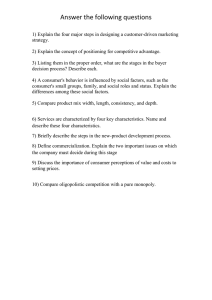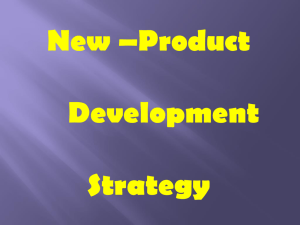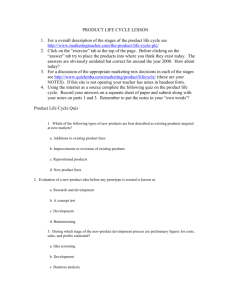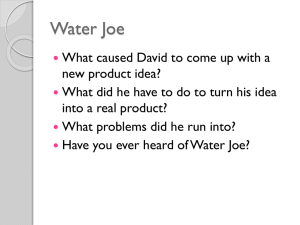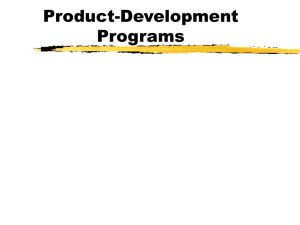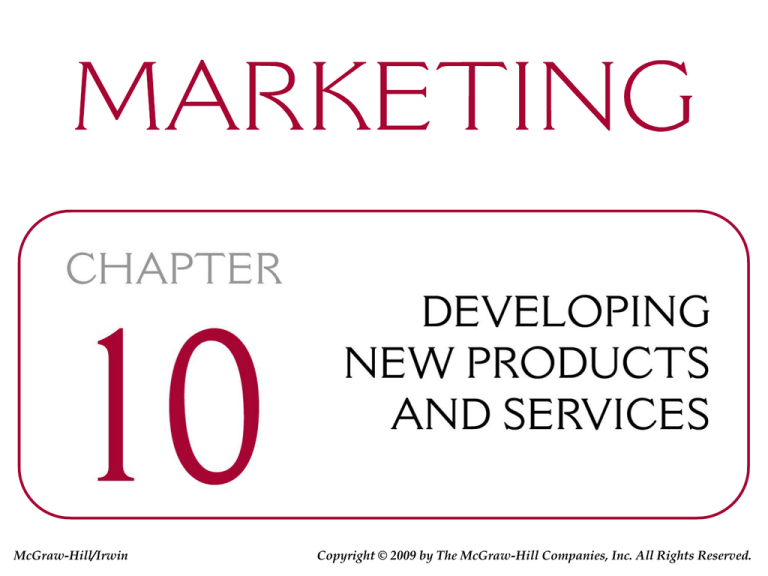
McGraw-Hill/Irwin
Copyright © 2009 by The McGraw-Hill Companies, Inc. All Rights Reserved.
Product
A product is a good, service,
or idea consisting of a bundle of
tangible and intangible attributes
that satisfies consumers and is
received in exchange for money
or some other unit of value.
10-2
LO1
THE VARIATION OF PRODUCTS
PRODUCT, PRODUCT LINE, AND PRODUCT MIX
Product Line
• Product Item
• Stock Keeping Unit (SKU)
Product Mix
10-3
LO1
THE VARIATION OF PRODUCTS
CLASSIFYING PRODUCTS
Type of User
• Consumer Goods
• Business Goods
10-4
LO1
THE VARIATION OF PRODUCTS
CLASSIFYING PRODUCTS
Degree of Tangibility
• Nondurable Goods
• Durable Goods
• Services
10-5
LO2
CLASSIFYING CONSUMER AND
BUSINESS GOODS
CLASSIFYING CONSUMER GOODS
Convenience Goods
Shopping Goods
Specialty Goods
Unsought Goods
10-6
FIGURE 10-1 How a consumer good is
classified affects what products consumers
buy and the marketing strategies used
10-7
LO2
CLASSIFYING CONSUMER AND
BUSINESS GOODS
CLASSIFYING BUSINESS GOODS
Derived Demand
Production Goods
Support Goods
• Installations
• Supplies
• Accessory
Equipment
• Industrial
Services
10-8
LO3
NEW PRODUCTS AND WHY
THEY SUCCEED OR FAIL
WHAT IS A NEW PRODUCT?
Newness Compared with
Existing Products
Newness in Legal Terms
10-9
LO3
NEW PRODUCTS AND WHY
THEY SUCCEED OR FAIL
WHAT IS A NEW PRODUCT?
Newness From the
Organization’s Perspective
• Product Line Extension
• Significant Jump in Innovation
• True Innovation
10-10
LO3
NEW PRODUCTS AND WHY
THEY SUCCEED OR FAIL
WHAT IS A NEW PRODUCT?
Newness From the Consumer’s
Perspective
• Continuous Innovation
• Dynamically Continuous Innovation
• Discontinuous Innovation
10-11
FIGURE 10-2 The degree of “newness” in a
new product affects the amount of learning
effort consumers exert to use the product
10-12
LO4
NEW PRODUCTS AND WHY
THEY SUCCEED OR FAIL
WHY PRODUCTS SUCCEED OR FAIL
Marketing Reasons for New-Product
Failures
• Insignificant Points of Difference
• Incomplete Market and Product Definition
Before Product Development Starts
Protocol
• Too Little Market Attractiveness
10-13
LO4
NEW PRODUCTS AND WHY
THEY SUCCEED OR FAIL
WHY PRODUCTS SUCCEED OR FAIL
Marketing Reasons for New-Product
Failures
• Poor Execution of the Marketing Mix
• Poor Product Quality or Sensitivity to
Customer Needs on Critical Factors
• Bad Timing
• No Access to Buyers
10-14
FIGURE 10-4 Stages in the new-product
process
10-15
FIGURE 10-B Strategic roles of most
successful new products
10-16
LO5
THE NEW-PRODUCT PROCESS
NEW-PRODUCT STRATEGY DEVELOPMENT
New-Product Process
New-Product Strategy Development
Objectives: Identify Markets and
Strategic Roles
• SWOT Analysis • Environmental Scanning
Improve Innovation: Use
Cross-Functional Teams
10-17
THE NEW-PRODUCT PROCESS
LO5
IDEA GENERATION
Idea Generation
Customer and Supplier Suggestions
Employee and Co-Worker Suggestions
R&D Breakthroughs
Competitive Products
Universities, Inventors, and
Small Tech Firms
10-18
LO5
THE NEW-PRODUCT PROCESS
SCREENING AND EVALUATION
Screening and Evaluation
Internal Approach
External Approach
10-19
LO5
THE NEW-PRODUCT PROCESS
BUSINESS ANALYSIS AND DEVELOPMENT
Business Analysis
Development
10-20
LO5
THE NEW-PRODUCT PROCESS
MARKET TESTING
Market Testing
Test Marketing
Simulated Test Markets (STMs)
10-21
LO5
THE NEW-PRODUCT PROCESS
COMMERCIALIZATION
Commercialization
Regional Rollouts
10-22
FIGURE 10-6 Marketing information and
methods used in each stage of the newproduct process
10-23
LO5
THE NEW-PRODUCT PROCESS
COMMERCIALIZATION
The Risks and Uncertainties
• Slotting Fee
• Failure Fee
10-24

